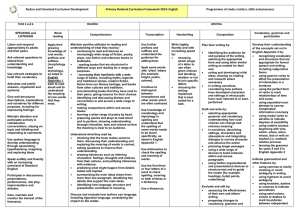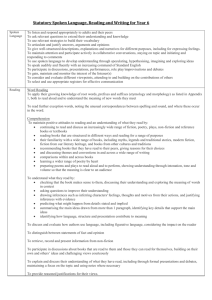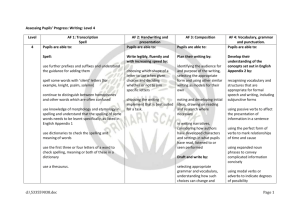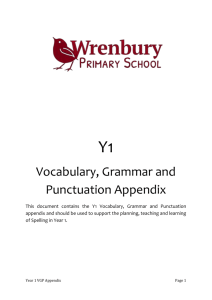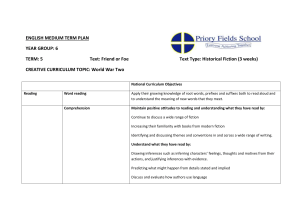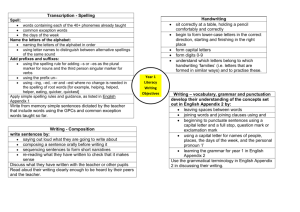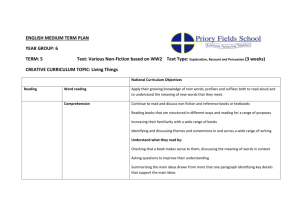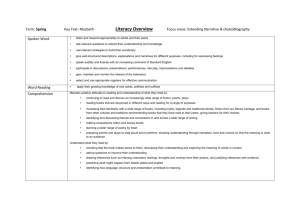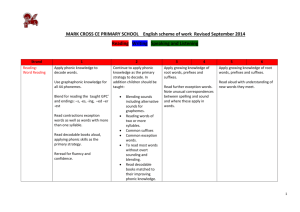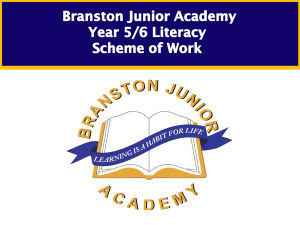Reading – word reading
advertisement
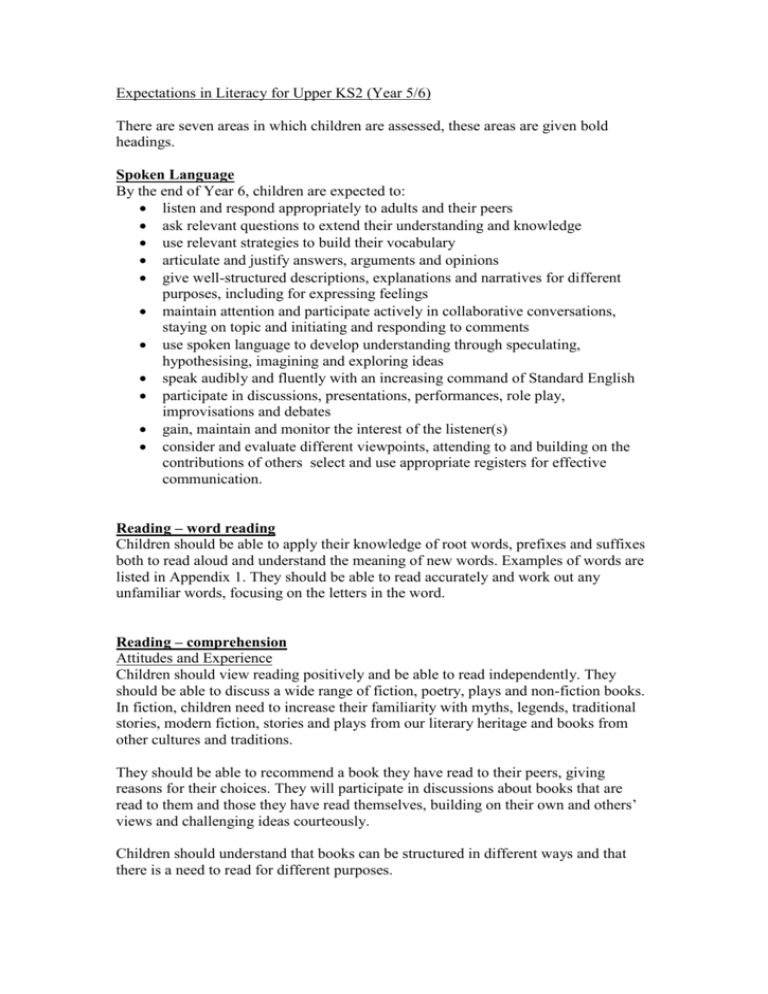
Expectations in Literacy for Upper KS2 (Year 5/6) There are seven areas in which children are assessed, these areas are given bold headings. Spoken Language By the end of Year 6, children are expected to: listen and respond appropriately to adults and their peers ask relevant questions to extend their understanding and knowledge use relevant strategies to build their vocabulary articulate and justify answers, arguments and opinions give well-structured descriptions, explanations and narratives for different purposes, including for expressing feelings maintain attention and participate actively in collaborative conversations, staying on topic and initiating and responding to comments use spoken language to develop understanding through speculating, hypothesising, imagining and exploring ideas speak audibly and fluently with an increasing command of Standard English participate in discussions, presentations, performances, role play, improvisations and debates gain, maintain and monitor the interest of the listener(s) consider and evaluate different viewpoints, attending to and building on the contributions of others select and use appropriate registers for effective communication. Reading – word reading Children should be able to apply their knowledge of root words, prefixes and suffixes both to read aloud and understand the meaning of new words. Examples of words are listed in Appendix 1. They should be able to read accurately and work out any unfamiliar words, focusing on the letters in the word. Reading – comprehension Attitudes and Experience Children should view reading positively and be able to read independently. They should be able to discuss a wide range of fiction, poetry, plays and non-fiction books. In fiction, children need to increase their familiarity with myths, legends, traditional stories, modern fiction, stories and plays from our literary heritage and books from other cultures and traditions. They should be able to recommend a book they have read to their peers, giving reasons for their choices. They will participate in discussions about books that are read to them and those they have read themselves, building on their own and others’ views and challenging ideas courteously. Children should understand that books can be structured in different ways and that there is a need to read for different purposes. They should identify and discuss themes in books. Also they should be aware of the conventions of different types of writing, such as how a biography differs from an autobiography. They should be able to make comparisons within and across books. Children should be able to learn different of poems off by heart, preparing them to read aloud and to perform, using and controlling their voice well to communicate the meaning of the poem clearly to an audience. Understanding Children should have a good understanding of what they have read, discussing their understanding and exploring the meaning of words in context. Furthermore, they will communicate this understanding of the texts they have read through formal presentations and debates, maintaining a focus on the topic and using notes where necessary. Reasoned justifications for views must be provided. They should be able to ask and answer questions about what they have read and conduct their own research, finding the answers to their questions. Children should be able to retrieve, record and present information from non-fiction texts. Children should be able to draw inferences about the characters’ feelings, thoughts and motives and justify their inferences by referring back to a particular part of the story. They should be able to predict what might happen next using clues from the story. They should be able to summarise the main ideas drawn from more than one paragraph, identifying the key details that support the main ideas. In addition, they must be able to identify how the language, structure and presentation contribute to meaning. They must be able to distinguish between statements of fact and opinion. Children should be able to discuss and evaluate how authors use language, considering the impact on the reader. Writing – transcription Spelling (see English Appendix 1) Pupils should be able to: use further prefixes and suffixes and understand the reasons for adding them spell some words with ‘silent’ letters [for example, knight, psalm, solemn] continue to distinguish between homophones and other words which are often confused use knowledge of morphology and etymology in spelling and understand that the spelling of some words needs to be learnt specifically, as listed in English Appendix 1 use dictionaries to check the spelling and meaning of words use the first three or four letters of a word to check spelling, meaning or both of these in a dictionary use a thesaurus. Handwriting Children should be able to write legibly, fluently and with increasing speed. They should know the letter shapes and which letters to join. They should be clear about what standard of handwriting is appropriate for a particular task e.g quick notes or a final best version. They should use an unjoined style for labelling a diagram and know when to use capital letters e.g. filling in a form. Writing – Composition Planning Children should be able to plan their writing by identifying the audience for and purpose of the writing, selecting the appropriate form and using other similar writing as models for their own. They should note and develop initial ideas, drawing on reading and research where necessary. When writing stories, pupils should consider how authors have developed characters and settings in what pupils have read, listened to or seen performed. Drafting and Writing Children should select appropriate grammar and vocabulary, understanding how such choices can change and enhance meaning. In story writing, they should describe settings, characters and atmosphere and add dialogue to convey character and advance the action. They should use a wide range of devices to build cohesion within and across paragraphs. They must also use further organisational and presentational devices to structure text and to guide the reader [for example, headings, bullet points, underlining]. Evaluating and Editing Children should be able to assess the effectiveness of their own and others’ writing, suggesting changes to vocabulary, grammar and punctuation to enhance effects and clarify meaning. They must ensure the consistent and correct use of tense throughout a piece of writing as well as ensuring correct subject and verb agreement when using singular and plural. They must be able to distinguish between the language of speech and writing. It is essential that the child proof-reads for spelling and punctuation errors. Children will be able to perform what they have written, using a clear, controlled voice and movements so that the meaning of their writing is clear to others. Writing – Vocabulary, Grammar and Punctuation Note: A link to the glossary of terms is included. Pupils should be able to develop their understanding of the concepts set out in English Appendix 2 by: recognising vocabulary and structures that are appropriate for formal speech and writing, including subjunctive forms using passive verbs to affect the presentation of information in a sentence using the perfect form of verbs to mark relationships of time and cause using expanded noun phrases to convey complicated information concisely using modal verbs or adverbs to indicate degrees of possibility using relative clauses beginning with who, which, where, when, whose, that or with an implied (i.e. omitted) relative pronoun learning the grammar for Years 5 and 6 in English Appendix 2 Children should be able to indicate grammatical and other features by: using commas to clarify meaning or avoid ambiguity in writing using hyphens to avoid ambiguity using brackets, dashes or commas to indicate parenthesis using semi-colons, colons or dashes to mark boundaries between independent clauses using a colon to introduce a list punctuating bullet points consistently Children must use and understand the grammatical terminology in English Appendix 2 accurately and appropriately in discussing their writing and reading.
